Numerical and Laboratory Investigations of Closely-Spaced and Joint Infiltration of Precipitation and Treated Waste Water
Abstract
:1. Introduction
- Prevent a significant hydraulic influence on the infiltration of treated waste water in case of simultaneous occurrence of precipitation infiltration.
- Avoid pronounced periods of fully saturated conditions below the adjacent treated waste water infiltration ditch or joint infiltration ditch, respectively, due to the additionally infiltrated precipitation water quantities.
- Allow for sufficient subsurface retention space for infiltration of treated waste water and precipitation water.
- Provide sufficient oxygen supply to reduce influence on the purification of treated waste water also for joint treated waste water and precipitation water infiltration.
2. Materials and Methods
2.1. Laboratory Tank
2.1.1. Tank Concept, Build-Up, and Instrumentation
2.1.2. Scenario Design Based on Real-World Downscaling
2.1.3. Analytics
2.2. Numerical Set-Up
3. Results
3.1. Hydraulic Behavior
3.2. Water Quality and Purification Performance
4. Discussion
- (1)
- Lower boundary condition of the tank and its numerical representationAs previously discussed in the Results section, the lower boundary of the tank seems to behave not consistently over time, rather it varies, conceptually speaking, between a free drainage boundary, a seepage face, and a boundary with even more resistance against vertical outflow. When the infiltration rate is increased, the lower boundary creates a resistance that leads to ponding (see water contents in scenarios WW-RE-24 (sep./jnt.) and WW-RE-Int (sep./jnt.). The installed perforated plate (63 µm mesh size) at the lower boundary of the tank is not able to drain the water fast enough, as it is simulated in the model. Numerical consideration of time-variable minimum pressures for outflow, based on measurements, are recommended, which would allow the inclusion of this behavior into calibration process in order to avoid these deviations.
- (2)
- The impact of unknown heterogeneities on the measurements as compared to numerical representationNumerical reproduction of the water contents measured generally shows good agreement (see Table 7 and Table 8). However, numerical reproducibility varies between observation points and also reference and repetition scenarios. The first might be due to small-scale heterogeneities. Although the procedure of packing the tank was done with great care, local compaction might occur. In contrast of a homogenous assumption, the sediment inserted has to be considered to be heterogeneous. This can be the reason for differences between water content measurement and numerical simulation, as e.g., seen at observation point P2 in the “sep.” models with additional precipitation infiltration and observation point P1 in most of the “jnt.” models.
- (3)
- The impact of the maximum variability of measured data to obtaine a good calibrationThe calibration and validation procedure is part of the overall modeling strategy [36]). However, the calibration period should include a sufficiently large variability of the process variable (here: water content / pressure head) in space and time. A simple explanation can be given by inversely estimating minimum and maximum water contents of the van Genuchten retention function [22]. If the water contents at a certain observation point only vary between a small bandwidth, e.g. between 0.15 and 0.25, the inverse parameter estimation procedure is not able, in certainty, quantify whether a maximum water content is 0.32 or 0.38, or will the procedure provide a good result for the residual water content.
5. Conclusions
Supplementary Materials
Author Contributions
Funding
Acknowledgments
Conflicts of Interest
References
- Stefan, C.; Ansems, N. Web-based global inventory of managed aquifer recharge applications. Sustain. Water Resour. Manag. 2018, 4, 153–162. [Google Scholar] [CrossRef]
- Zheng, F.; Zhai, Y.; Xia, x.; Yin, Z.; Du, Q.; Zuo, R.; Wang, J.; Teng, Y.; Xu, M. Simulation of trinitrogen migration and transformation in the unsaturated zone at a desert contaminant site (NW China) using hydrus-2d. Water 2018, 10, 1363. [Google Scholar] [CrossRef]
- Pyne, R.D.G. Groundwater Recharge and Wells. In A Guide to Aquifer Storage Recovery; CRC Press: Boca Raton, FL, USA, 1995; p. 400. [Google Scholar]
- Ebeling, P.; Händel, F.; Walther, M. Potential of mixed hydraulic barriers to remediate seawater intrusion. Sci. Total. Environ. 2019, 693, 133478. [Google Scholar] [CrossRef] [PubMed]
- Asano, T.; Cotruvo, J.A. Groundwater recharge with reclaimed municipal wastewater: Health and regulatory considerations. Water Res. 2004, 38, 1941–1951. [Google Scholar] [CrossRef] [PubMed]
- Bekele, E.; Page, D.; Vanderzalm, J.; Kaksonen, A.; Gonzalez, D. Water recycling via aquifers for sustainable urban water quality management: Current status, challenges and opportunities. Water 2018, 10, 457. [Google Scholar] [CrossRef]
- Elkayam, R.; Sopliniak, A.; Gasser, G.; Pankratov, I.; Lev, O. Oxidizer demand in the unsaturated zone of a surface–spreading soil aquifer treatment system. Vadose Zone J. 2015, 14. [Google Scholar] [CrossRef]
- Paul, J.D.; Blunt, M.J. Wastewater filtration and re-use: An alternative water source for London. Sci. Total. Environ. 2012, 437, 173–184. [Google Scholar] [CrossRef] [PubMed]
- Van Afferden, M.; Cardona, J.A.; Lee, M.Y.; Subah, A.; Müller, R.A. A new approach to implementing decentralized waste water treatment concepts. Water Sci. Technol. 2015, 72, 1923–1930. [Google Scholar] [CrossRef] [PubMed]
- Quanrud, D.M.; Arnold, R.G.; Wilson, L.G.; Conklin, M.H. Effect of soil type on water quality improvement during soil aquifer treatment. Water Sci. Technol. 1996, 33, 419–431. [Google Scholar] [CrossRef]
- Martins, T.; Leitao, T.E.; Carvalho, M.R. Assessment of wastewater contaminants retention for a soil-aquifer treatment system using soil-column experiments. Procedia Earth Planet. Sci. 2017, 17, 332–335. [Google Scholar] [CrossRef]
- Reemtsma, T.; Gnirb, R.; Jekel, M. Infiltration of combined sewer overflow and tertiary municipal wastewater: An integrated laboratory and field study on nutrients and dissolved organics. Water Res. 2000, 34, 1179–1186. [Google Scholar] [CrossRef]
- Zhang, Z.; Lei, Z.; Zhang, Z.; Sugiura, N.; Xu, x.; Yin, D. Organics removal of combined wastewater through shallow soil infiltration treatment: A field and laboratory study. J. Hazard. Mater. 2007, 149, 657–665. [Google Scholar] [CrossRef] [PubMed]
- German Environment Agency. Available online: https://www.umweltbundesamt.de/themen/wasser/grundwasser (accessed on 25 July 2019).
- Directive, W.F. Directive 2000/60/EC of the European Parliament and of the Council establishing a framework for the Community action in the field of water policy. Off. J. Eur. Communities 2000, 327, 22. [Google Scholar]
- German Federal Ministry of Justice and Consumer Protection. German Federal Water Act; BGBl: Berlin, German, 2018; p. 2254. [Google Scholar]
- BGBI. Small Waste Water Treatment Systems for up to 50 Pt–Part 3: Packaged and/or Site Assembled Domestic Waste Water Treatment Plants; DIN Deutsches Institut für Normung e.V.: Berlin, Germany, 2016; p. 46. [Google Scholar]
- BGBI. DIN 4261-1. Small Sewage Treatment Plants—Part 1: Plants for Waste Water Pretreatment; DIN Deutsches Institut für Normung e.V.: Berlin, Germany, 2010; p. 15. [Google Scholar]
- BGBI. DIN 4261-5. Small Sewage Treatment Plants—Part 5: Infiltration of Aerobic Biologically Treated Domestic Waste Water; DIN Deutsches Institut für Normung e.V.: Berlin, Germany, 2012; p. 10. [Google Scholar]
- Händel, F.; Engelmann, C.; Klotzsch, S.; Fichtner, T.; Binder, M.; Graeber, P.W. Evaluation of decentralized, closely-spaced precipitation water and treated waste water infiltration. Water 2018, 10, 1460. [Google Scholar] [CrossRef]
- Hyprop System. Available online: https://www.metergroup.com/environment/products/hyprop-2/ (accessed on 24 April 2019).
- Van Genuchten, M.T. A closed-form equation for predicting the hydraulic conductivity of unsaturated soils 1. Soil Sci. Soc. Am. J. 1980, 44, 892–898. [Google Scholar] [CrossRef]
- BGBI. DIN EN ISO 17892-11. Geotechnical Investigation and Testing—Laboratory Testing of Soil—Part 11: Permeability Tests; DIN Deutsches Institut für Normung e.V.: Berlin, Germany, 2019; p. 20. [Google Scholar]
- Mualem, Y. A new model for predicting the hydraulic conductivity of unsaturated porous media. Water Resour. Res. 1976, 12, 513–522. [Google Scholar] [CrossRef] [Green Version]
- BGBI. DIN EN ISO 11272. Soil Quality–Determination of Dry Bulk Density; DIN Deutsches Institut für Normung e.V.: Berlin, Germany, 2017; p. 14. [Google Scholar]
- Dostmann, H.; M & S Umweltprojekt GmbH, Plauen, Germany. Personal communication, 2018.
- Märtner, B.; Gräber, P.W.; Bergmann Sen, M. Verbundprojekt RESS-199-016 ESEK Ganzheitliches System zur Errichtung von Kleinkläranlagen; M & S Umweltprojekt GmbH: Plauen, Germany, 2013; p. 74. [Google Scholar]
- German Federal Ministry for the Environment Conservation Construction and Nuclear Safety. German Groundwater Ordinance; German Federal Ministry for the Environment Conservation Construction and Nuclear Safety: Berlin Germany, 2017; p. 1044.
- DWA-A 138. Planning, Construction and Operation Ofrainwater Infiltration Systems; DWA German Association for Water, Wastewater and Waste: Hennef, Germany, 2005; p. 62. [Google Scholar]
- KOSTRA-DWD; Version 3.1; Coordinated Heavy Precipitation Regionalization Evaluations; German Weather Service (DWD): Offenbach, Germany, 2010.
- Šimůnek, J.; Van Genuchten, M.T.; Šejna, M. Recent developments and applications of the HYDRUS computer software packages. Vadose Zone J. 2016, 15, 25. [Google Scholar] [CrossRef]
- Richards, L.A. Capillary conduction of liquids through porous mediums. J. Appl. Phys. 1931, 1, 318–333. [Google Scholar] [CrossRef]
- Šejna, M.; Šimůnek, J.; Van Genuchten, M.T. The HYDRUS Software Package for Simulating the Two- and Three-Dimensional Movement of Water, Heat, and Multiple Solutes in Variably-Saturated Porous Media; User Manual Version 3.01; PC-Progress: Prague, Czech Republic; Riverside, CA, USA; Rio de Janeiro, Brazil; Utrecht, The Netherlands, 2018; p. 324. [Google Scholar]
- Šimůnek, J.; PC-Progress, Prague, Czech Republic. Personal communication, 2018.
- Stevens Water Monitoring Systems, Inc. HydraProbe Soil Sensor, User’s Manual; Stevens Water Monitoring Systems, Inc.: Portland, OR, USA, 2018; p. 63. [Google Scholar]
- Anderson, M.P.; Woessner, W.W.; Hunt, R.J. Applied Groundwater Modelling: Simulation of Flow and Advective Transport; Academic Press: Cambridge, MA, USA, 2015; p. 630. [Google Scholar]
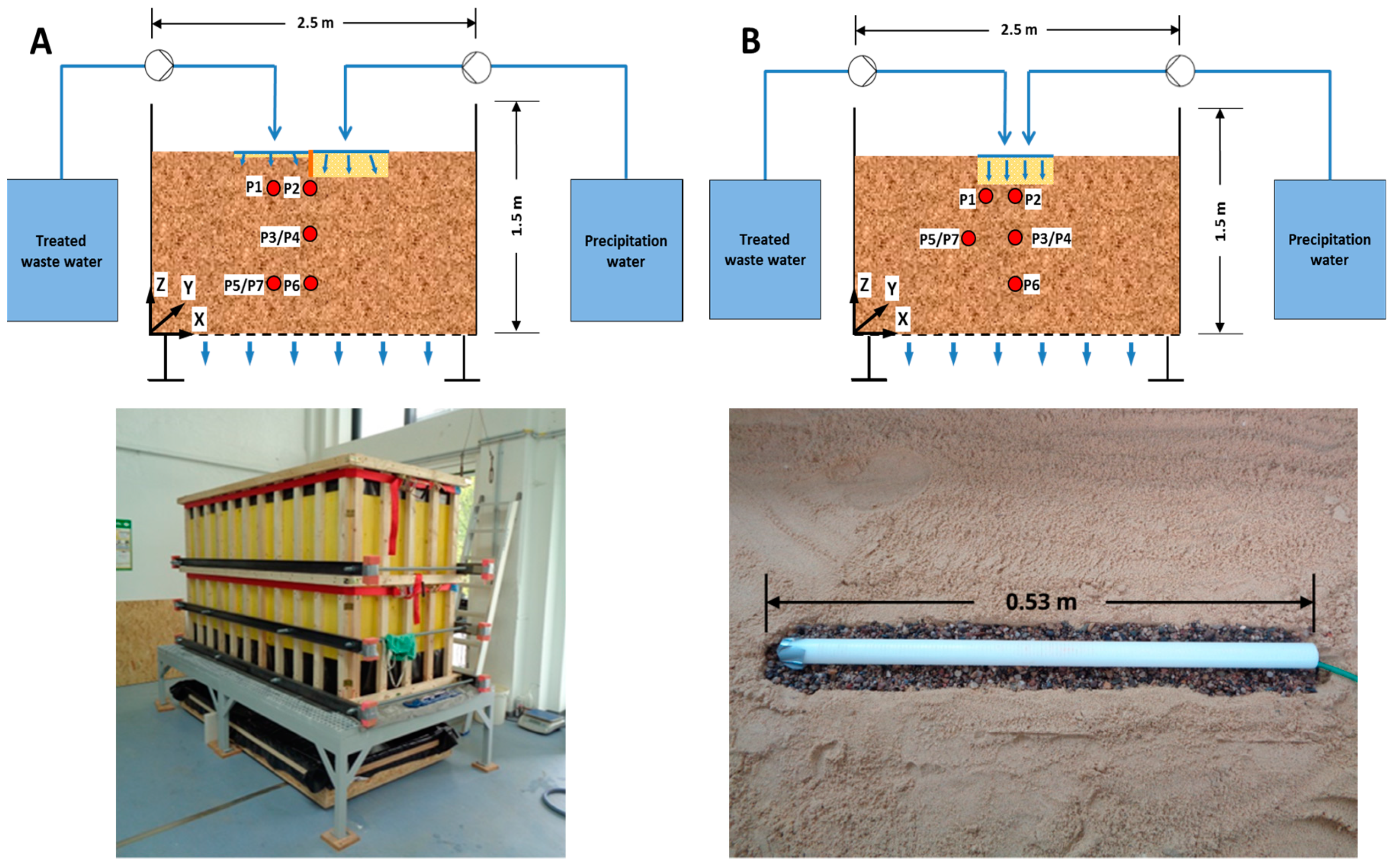

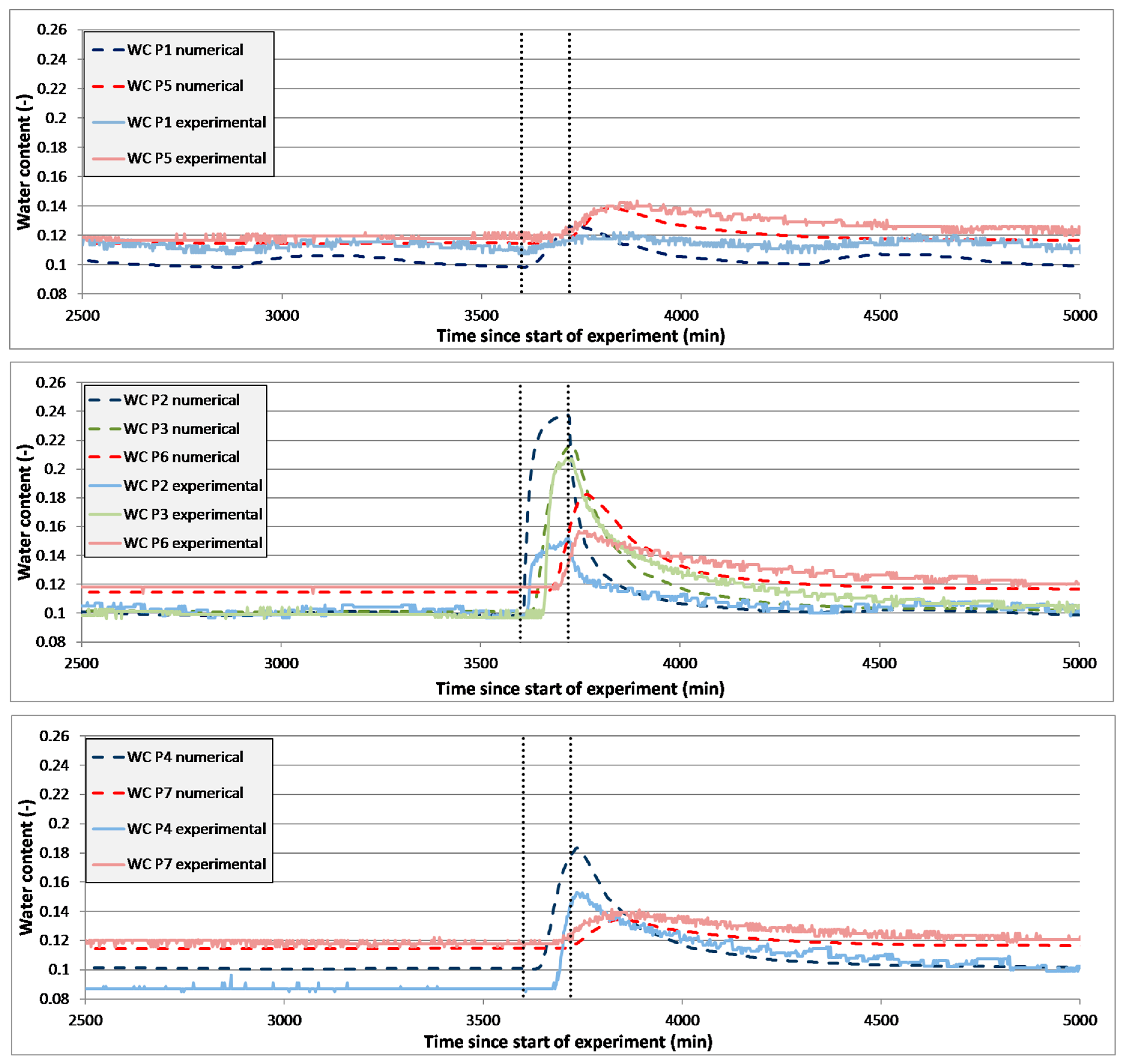

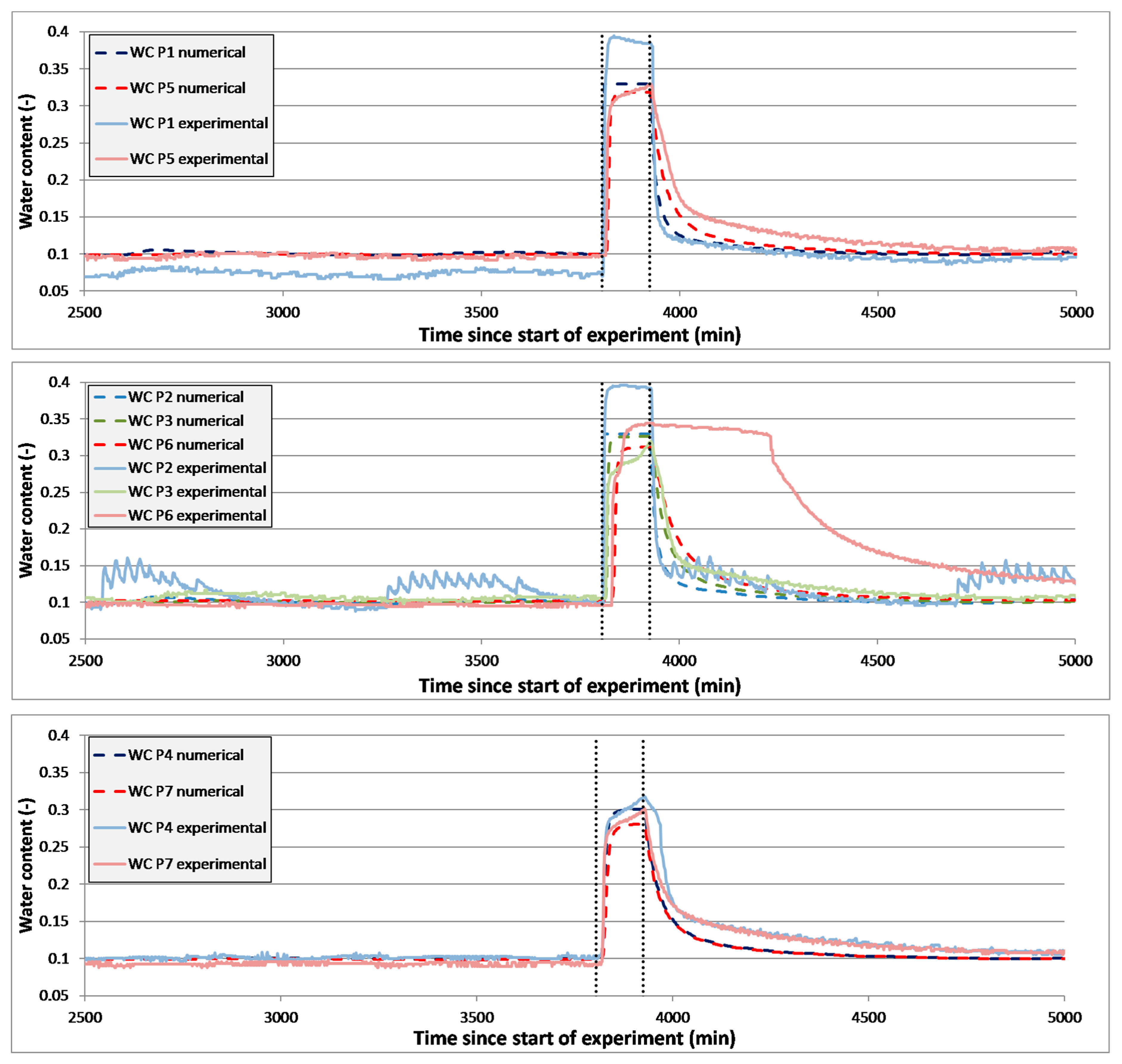
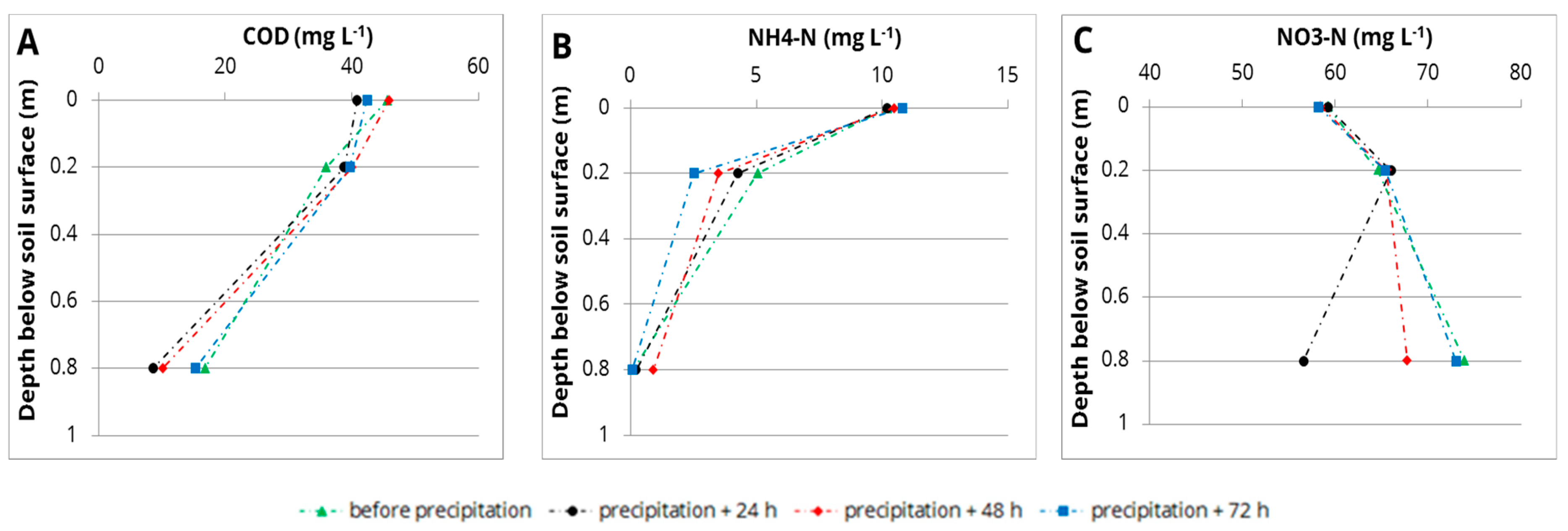
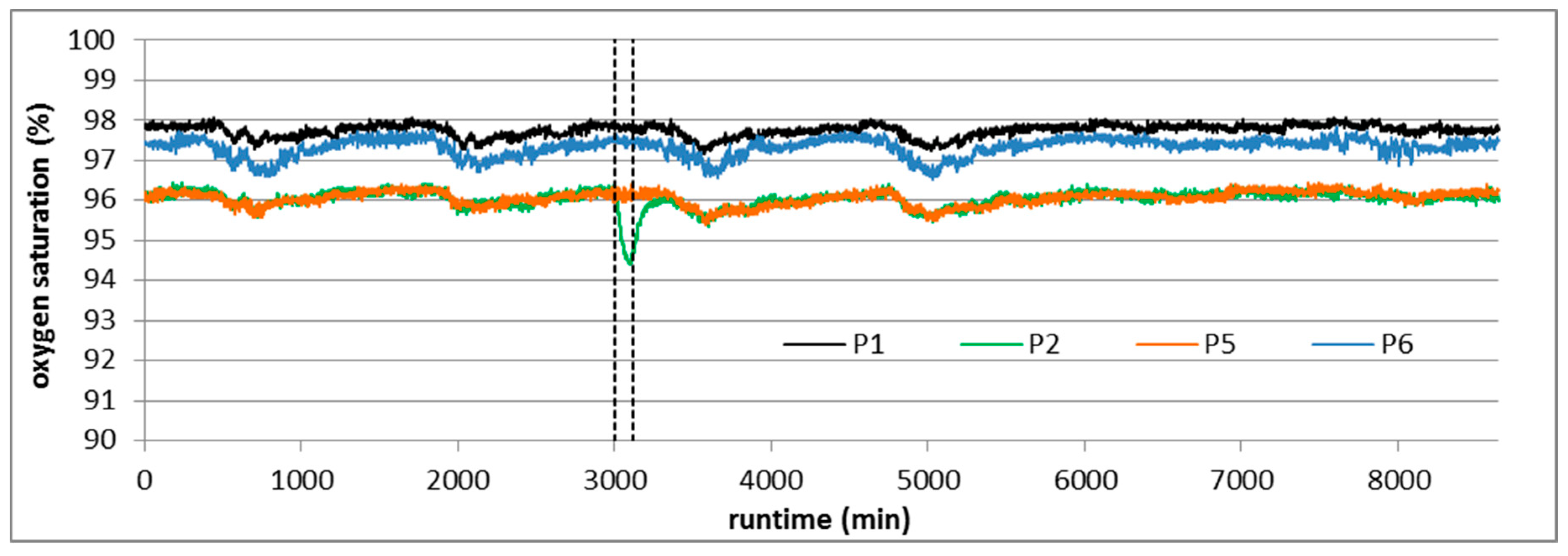
| Parameter | Sample 1 | Sample 2 | Sample 3 |
|---|---|---|---|
| Van Genuchten shape parameter α (cm−1) | 0.0402 | 0.0326 | 0.0272 |
| Van Genuchten shape parameter n (−) | 4.124 | 4.055 | 4.256 |
| Residual water content θr (cm3 cm−3) | 0.123 | 0.1 | 0.094 |
| Saturated water content θs (cm3 cm−3) | 0.394 | 0.355 | 0.363 |
| Bulk density ρb (g cm−3) | 1.59 | 1.68 | 1.67 |
| Saturated hydraulic conductivity K (cm day−1) | 363 | ||
| Observation Point | Closely Spaced, Separated Ditches (X;Y;Z) | Equipped with | Joint Ditches (X;Y;Z) | Equipped with |
|---|---|---|---|---|
| P1 | 96; 49; 95 | WC, O2, SC | 1105; 49; 90 | WC, SC |
| P2 | 1255; 49; 95 | WC, O2, SC | 1255; 49; 90 | WC, O2, SC |
| P3 | 1255; 49; 65 | WC, SC | 1255; 49; 65 | WC, O2, SC |
| P4 | 1255; 25; 65 | WC | 1255; 25; 65 | WC |
| P5 | 96; 49; 35 | WC, O2, SC | 1005; 49; 65 | WC, O2, SC |
| P6 | 1255; 49; 35 | WC, O2, SC | 1255; 49; 35 | WC, O2, SC |
| P7 | 96; 25; 35 | WC | 1005; 25; 65 | WC |
| Infiltration System | Type of Ditch | Real World | 3D-Tank |
|---|---|---|---|
| Separate Infiltration | Treated waste water ditch (L × W × H) (m) | 8 × 0.5 × 0.5 | 0.53 × 0.035 × 0.035 |
| Precipitation ditch (L × W × H) (m) | 6 × 2 × 2.5 | 0.40 × 0.135 × 0.17 | |
| Joint Infiltration | Treated waste water + Precipitation Ditch (L × W × H) (m) | 8 × 2 × 3 | 0.53 × 0.135 × 0.20 |
| Type of Water | pH (−) | EC (µS cm−1) | COD | NO2-N | NO3-N | NH4-N | Total P | SO42− | Cl− |
|---|---|---|---|---|---|---|---|---|---|
| (mg L−1) | |||||||||
| TWW | 7.45 | 1174 | 45.5 | 0.67 | 52 | 12.4 | 29 | 80 | 110 |
| PW | 6.2 | 58 | n.d. | n.d. | 2 | n.d. | n.d. | 5.3 | 3.6 |
| Limit Value acc. to [28] | 6.5–9.5 | 2790 | n.a. | 0.15 | 11.3 | 0.39 | n.a. | 250 | 250 |
| Scenario | Abbreviation | Description | Ditch Arrangement |
|---|---|---|---|
| Reference scenario only waste water infiltration | WW-Ref | Waste water is infiltrated by a rate of 39.9 L day−1 (0.3 L min−1) which includes a scaling factor of 15. | separated |
| Repetition scenario for waste water infiltration | WW-Rep | Same as for WW-Ref | separated |
| Reference scenario waste water and precipitation water infiltration | WW-RE-Ref | Waste water is infiltrated by a rate of 2.7 L day−1 (0.02 L min−1). Precipitation water is infiltrated at a rate of 0.425 L min−1 for 120 min., both including a scaling factor of 225. | separated and joint |
| Repetition scenario 1 for waste water and precipitation water infiltration | WW-RE-Rep-1 | Same as for WW-RE-Ref | separated and joint |
| Repetition scenario 2 for waste water and precipitation water infiltration | WW-RE-Rep-2 | Same as for WW-RE-Ref | separated and joint |
| Scenario waste water and precipitation water infiltration for 24 h | WW-RE-24 | Waste water is infiltrated by a rate of 2.7 L day−1 (0.02 L min−1). Precipitation water is infiltrated at a rate of 0.425 L min−1 for 1440 min. | separated and joint |
| Scenario waste water and precipitation water infiltration with 5 times higher intensity | WW-RE-Int | Waste water is infiltrated by a rate of 2.7 L day−1 (0.02 L min−1). Precipitation water is infiltrated at a rate of 2.125 L min−1 for 120 min. | separated and joint |
| Parameter | Separated Ditches | Joint Ditch |
|---|---|---|
| Van Genuchten shape parameter α (cm−1) | 0.05 | 0.1 |
| Van Genuchten shape parameter n (−) | 4.0 | 3.5 |
| Residual water content θr (cm3 cm−3) | 0.095 | 0.095 |
| Saturated water content θs (cm3 cm−3) | 0.33 | 0.33 |
| Pore connectivity parameter in the conductivity function l (−) | −1.0 | −1.0 |
| Saturated hydraulic conductivity K (cm day−1) | 360 | 720 |
| Scenario | RMSE | MAE | RMSE (Precipitation Event) | MAE (Precipitation Event) |
|---|---|---|---|---|
| WW-Ref | 0.0131 | 0.0116 | - | - |
| WW-Rep | 0.0121 | 0.0111 | - | - |
| WW-RE-Ref | 0.0125 | 0.0067 | 0.0120 | 0.0080 |
| WW-RE-Rep-1 | 0.0120 | 0.0067 | 0.0139 | 0.0100 |
| WW-RE-Rep-2 | 0.0124 | 0.0065 | 0.0146 | 0.0094 |
| WW-RE-24 | 0.0324 | 0.0190 | 0.0455 | 0.0452 |
| WW-RE-Int | 0.0222 | 0.0100 | 0.0609 | 0.0447 |
| Scenario | RMSE | MAE | RMSE (Precipitation Event) | MAE (Precipitation Event) |
|---|---|---|---|---|
| WW-RE-Ref | 0.0149 | 0.0119 | 0.0271 | 0.0199 |
| WW-RE-Rep-1 | 0.0167 | 0.0135 | 0.0273 | 0.0185 |
| WW-RE-Rep-2 | 0.0129 | 0.0102 | 0.0254 | 0.0187 |
| WW-RE-24 | 0.0220 | 0.0138 | 0.0365 | 0.0285 |
| WW-RE-Int | 0.0168 | 0.0108 | 0.0392 | 0.0315 |
© 2019 by the authors. Licensee MDPI, Basel, Switzerland. This article is an open access article distributed under the terms and conditions of the Creative Commons Attribution (CC BY) license (http://creativecommons.org/licenses/by/4.0/).
Share and Cite
Händel, F.; Fichtner, T.; Graeber, P.-W. Numerical and Laboratory Investigations of Closely-Spaced and Joint Infiltration of Precipitation and Treated Waste Water. Water 2019, 11, 2262. https://doi.org/10.3390/w11112262
Händel F, Fichtner T, Graeber P-W. Numerical and Laboratory Investigations of Closely-Spaced and Joint Infiltration of Precipitation and Treated Waste Water. Water. 2019; 11(11):2262. https://doi.org/10.3390/w11112262
Chicago/Turabian StyleHändel, Falk, Thomas Fichtner, and Peter-Wolfgang Graeber. 2019. "Numerical and Laboratory Investigations of Closely-Spaced and Joint Infiltration of Precipitation and Treated Waste Water" Water 11, no. 11: 2262. https://doi.org/10.3390/w11112262
APA StyleHändel, F., Fichtner, T., & Graeber, P.-W. (2019). Numerical and Laboratory Investigations of Closely-Spaced and Joint Infiltration of Precipitation and Treated Waste Water. Water, 11(11), 2262. https://doi.org/10.3390/w11112262





